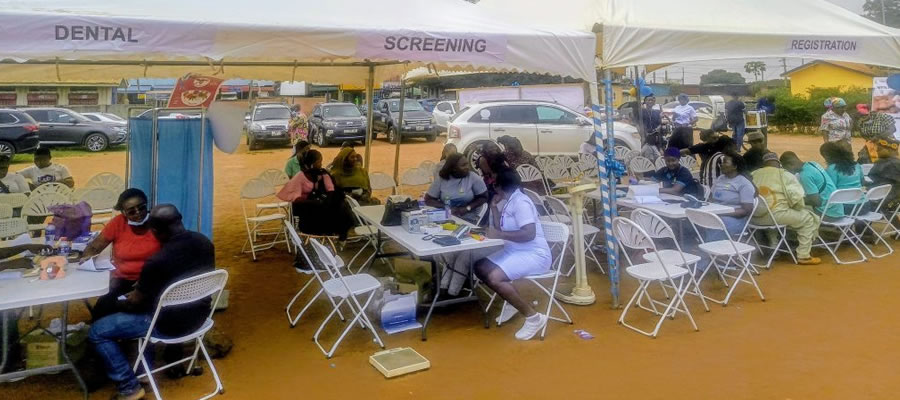

Introduction
The economic characteristics of a society are essential indicators of the level of economic development of the area and people’s involvement in economic activities. This chapter looks at the economic characteristics of the La Nkwantanang Madina Municipal as per the 2010 PHC. The characteristics considered are economic activity status, occupation, industry, employment status and employment sector of person’s aged 15 years and older.
Economic Activity Status
This section presents results on persons 15 years and older who were engaged in any legal economic activity for pay (cash or kind) or profit or family gain during the seven days preceding census night. Economically active are all persons (i) who worked for pay or profit or family gain during the seven days preceding the census or (ii) who did not work but had jobs to return to, such as those on leave with or without pay, temporarily ill persons, temporarily laid off persons or (iii) who did not work during the reference period, but were actively looking for work (i.e. the unemployed). On the other hand, economically not active are homemakers (persons who engaged in household duties without pay), students, the aged, pensioners and persons with disability (GSS, 2012).
Economic Activity Status by Sex
Table 4.1 shows that a total of 79,841 constitute the population 15 years or older living in the municipality. Out of this total, 68.9 per cent are economically active, while 31.1 percent constitute economically not active population.
Of the economically active population, 92.3 percent are employed while 7.7 percent are unemployed. In the Municipality, the proportion of the females (92.4%) that are employed is slightly higher than that of the males (92.2%). Furthermore, Table 4.1 reveals that more than half of the economically not active population are in full time education (56.7 %) and the disabled or sick constituted the least percentage (3.7 %). The large number of economically not active population in full time education means that the Municipality has the potential human capital for its future socio-economic development.
Table 4.2 shows the population 15years and older by age group, sex and activity status in the Municipality. The data for both sexes reveal that, the employment levels among the various age groups exhibit a normal distribution. The proportion of persons employed among the various age groups is observed to increase from 18.1 percent (for 15-19 years) and peaks at 89.0 percent (for 40-44 years) then decreases gradually to 32.8 percent (for persons 65 years and older).
The table again shows that, unemployment levels are generally low among the different age groups. However, the highest unemployment rate of 8.7 percent exists among the (20-24) year age-group. For the population economically not active, higher proportions are concentrated within the younger ages of 15-19 years (78.9%) and 20-24 years (44.4%) and also among the older ages of 65+ years (66.1%).
Similar patterns are observed for the sexes among the different age groups, with the male group having higher levels of the various activity statuses than their female counterpart.
Occupation
Occupation refers to the type of work a person is engaged in or a person’s principal or usual work or business especially as a means of earning a living. In the 2010 PHC, occupation was asked only of persons who worked for at least one hour during the seven days before the census night, and those who did not work but had a job to return to, as well as those who were unemployed but had worked before. All persons who worked during the seven days before the census night were classified by the kind of work they were engaged in. The emphasis was on the work the person did during the reference period.
Table 4.3 shows the employed population 15 years and older by occupation in the Municipality.
The results indicate that more than one-third (35.5 %) of the population (of both sexes) was engaged in service and sales work, especially females (51.8 %). This was expected because traditionally, such occupations are associated with females. Higher proportions of males than females are engaged in craft and related trades (28.3% and 15.7% respectively) and plant and machine operators and assemblers (14.3% and 0.4% respectively). This shows some level of gender stereotype in occupation in the Municipality. Table 4.3 also reveals that total population employed in skilled agriculture, forestry and fisheries was the least (1.8%).
Industry
In the 2010 PHC, information on industry was collected on the main products or services produced during the seven days before the census night. Table 4.4 shows employed population 15 years and older by industry and sex. Majority (29.2%) of persons 15 years and older who are employed are engaged in wholesale and retail, repair of motor vehicles and motor cycles category, particularly females (38.1%), indicating that females prefer working in those industries. A higher proportion of males (13.6 %) working the construction industry compared to the number of females who are involve (0.5 %). This is expected because jobs involving construction require much energy and are often regarded in most societies as male related occupations (Yendaw et al., 2013). In general, the informal sector was predominant in the Municipality.
Employment Status
Employment status referred to the position of a person in the establishment where he/she currently works or previously worked. In the 2010 PHC, eight employment status categories were provided: employee, self-employed without employees, self-employed with employees, casual worker, contributing family worker, apprentice and domestic employee (house-help).
From Table 4.5, majority (43.4%) of the working population constitute self-employed without employees, followed by employees (38.7%). For the sexes, the proportion male working population belonging to the employee category is relatively higher than that of their female counterpart (50.6% against 27.1%).
For the self-employed without employees, 55.0 percent are 42 females while 31.6 percent are males, signifying that more females are engaged in petty trading where employees are not needed. On self-employed with employee (s), the proportion is higher among the males (9.0%) than the females (7.9%). The results further show a higher percentage of the females (3.6%) than the males (1.4%) in the contributing family worker category. In the same way, a higher proportion of the females (0.9%) than the males (0.5%) are engaged as domestic employees (House helps). This is expected because females are mostly associated with family or domestic work (Tanle and Awusabo-Asare, 2007).
Employment Sector
Table 4.6 reveals that in the Municipality, majority (69.7%) of the working population are engaged in the private informal sector, while 17.6 percent are engaged in the private formal sector with the least are engaged in semi-parastatal (0.3%). Higher proportion of the females (78.8%) compared with the males (60.5%) are employed in the private informal sector.
This could be due to inadequate employment opportunities in the formal sector coupled with the fact that some people had low educational and professional training that did not meet the requisite qualifications for employment in the formal sector, particularly females (Tanle and Awusabo-Asare, 2007). The proportion of males (13.5%) employed in the public sector is far higher than that of the females (8.7%). This could be attributed to the fact that generally illiteracy level is higher among females than males in Ghana (GSS, 2012).
Date Created : 12/5/2017 3:52:49 AM









 facebook
facebook
 twitter
twitter
 Youtube
Youtube
 +233 593 831 280
+233 593 831 280 0800 430 430
0800 430 430 GPS: GE-231-4383
GPS: GE-231-4383 info@ghanadistricts.com
info@ghanadistricts.com Box GP1044, Accra, Ghana
Box GP1044, Accra, Ghana